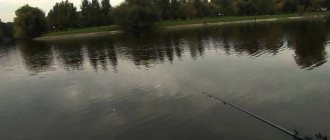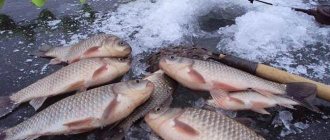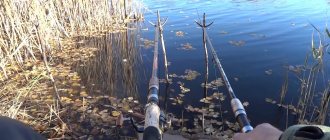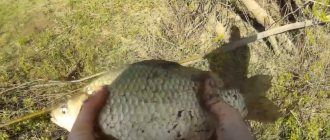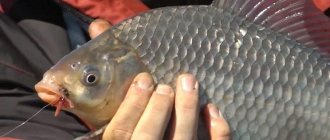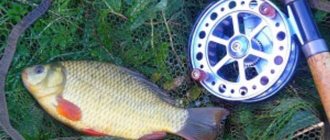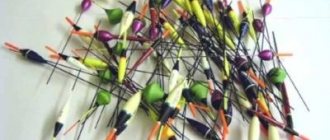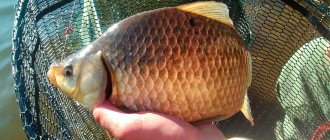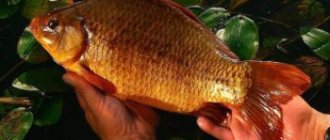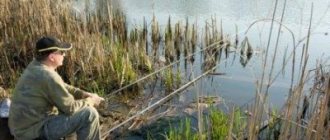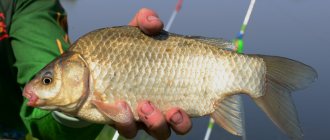The process of catching crucian carp in winter is something unattainable for some anglers, but for others it is commonplace. Winter fishing for this fish requires the manifestation of fishing skills, ingenuity and lack of laziness. Classics of the genre. Either the bait is not the same, or the crucian carp takes jigs for a certain game today, but tomorrow it will be different. Meanwhile, in the southern regions, where crucian carp (hybrid) forms the basis of fishing catches, catching this fish is the main activity of winter fishermen at this time of year. In this article we will look at the features and secrets of catching crucian carp in winter.
How does crucian carp winter?
Crucian carp hibernate in winter only in shallow muddy ponds, swamps and lakes in the northern regions. However, in these places the population is quite small. After all, the hybrid is a heat-loving fish, and also demanding of the level of oxygen in the water. Contrary to the prevailing opinion about the love of silver for stagnant water, let us explain. Yes, this representative of the ichthyofauna is tenacious, it adapts to difficult conditions, overwinters in silt, in reservoirs that freeze to the bottom, and the last one (except rotan) dies when killed.
But this does not mean that he “loves” low oxygen content in water. The hybrid prefers water saturated with this gas, like roach or perch, but to a lesser extent than grayling or pike perch. In addition, in cold water the metabolism is inhibited, and this fish prefers to hibernate (anabiosis) until better times. But this requires suitable conditions for hibernation. And this is the lack of a sufficient layer of water between the ice and the bottom and a thick layer of silt into which the hybrid burrows, becoming covered with protective mucus. It can live in cold water for weeks, but in a basin with warm water it will not live even three days; it will fall asleep.
Do crucian carp sleep in ponds in winter? Yes, but in small, deeply frozen ones and with the presence of a thick layer of silt (0.5 m or more). If there is nowhere to sleep, it is active all winter, and you can catch it, since to maintain life, the fish needs to feed (albeit an order of magnitude less than in summer).
In the southern regions (Rostov, Volgograd regions and further south) silver thrives. The usual trophy here is 0.7-1.5 kg. A half-kilogram hybrid is considered small. And in winter in these places it is the main representative in the fisherman’s catches (together with roach, ram, and roach). The name “hybrid” comes from these places. In fact, this fish is a pure silver crucian carp, which supplanted our native “golden” due to evolutionary advantages:
- Better adaptability to different conditions. It is omnipresent - rivers, ponds, reservoirs, lakes, small stakes become permanent habitats. Unlike its golden brother, the hybrid feels great in rivers with strong currents. In the Don, lower Volga, Kuban, and in all reservoirs and tributaries of these rivers, silver crucian carp thrives, reaching impressive sizes and weights (rarely up to 5 kg, and usually up to 1.5 kg). In the reservoirs of the middle zone, a normal specimen is crucian carp 400-700 grams.
- Viral spawning. The eggs of this fish are fertilized by the milk of any related cyprinids - golden carp, carp, etc. The places and timing of spawning of these fish coincide. And at the exit from such caviar, silver crucian carp grows. 90% of the population are females. By the way, that’s why the name “hybrid” has stuck with crucian carp. Here and there you can find the names “dushman” or even “buffalo”. Buffalo is another fish that is not related to the hybrid, even in appearance it is very different from our silver crucian carp.
What does crucian carp do in winter?
In the northern latitudes, where the silverfish mainly inhabits numerous ponds and swampy lakes, in the harsh winter it sleeps, buried in the bottom sediments. In the middle zone and in the south of the European part, the Urals and Siberia, it is active almost all winter in reservoirs where it is impossible to bury itself in the bottom (of which the vast majority are). In severe frosts, the fish are passive, often bite slowly, mulling the bait for a long time. Crucian carp is a benthophage and loves to rummage through bottom sediments in search of organisms living there (bloodworms and other larvae). However, in the warm season it also eats plant foods. In winter, the metabolism in the body is slowed down, the fish simply cannot move actively and eat a lot. Therefore, she tries to spend as little energy as possible searching for food (to save strength). Therefore, the main baits for ice fishing are of animal origin, rich in proteins.
Crucian carp are active at the beginning of winter; during the first ice, they even eat. With the onset of deep winter, activity decreases, schools of fish stand at points, sluggishly moving to places with a stable oxygen regime and the availability of food. But even on such days you can fish if you find a parking spot and offer the right bait.
By spring, activity increases again. Although it is still very cold, eggs are actively developing in the females, and more nutrients are required. To activate the bite, a slight thaw is enough, when fresh melt water begins to enter the reservoir. In ponds at this time, silver gourmets usually move from deep places to the shore, to the edge of the vegetation, where there is more food. In reservoirs - they return from holes and flooded channels to medium-shallow depths, up to 5 meters, moving closer to the mouths of inflowing rivers and to extensive coastal shallow waters.
It is impossible to say in general what part of the reservoir winters in; conditions are different everywhere. But it definitely doesn’t slide into holes, ten meters deep, like bream. More often it moves sluggishly somewhere near its summer camp sites. In small ponds, during periods of inactivity, fish stand in places with the greatest depth, 3-6 meters, moving during thaws and by spring to shallow waters or coastal edges. On large reservoirs migration is significant. The winter mooring site can be, for example, a bay with a depth of 5-6 meters, and by spring the schools move closer to the mouth, to the shores with thickets of reeds. With the melting of ice, fish can rise up the tributaries quite far to spawn, tens of kilometers (as, for example, in the Tsimlyansk Reservoir).
How to help crucian carp survive the winter
Healthy fish that live in an ecologically clean reservoir, where natural biological connections are not disrupted, do not need help with wintering. In order to survive normally until spring, the body of the inhabitant of the reservoir contains all the necessary reserves.
Important! Due to the natural slowing of metabolic processes, cold-blooded animals can go much longer without food when the temperature drops and at the same time experience a much lower need for oxygen.
Problems may arise if:
- the fish entered the winter injured or were affected by invasive or other diseases;
- there was not enough food in the reservoir for the crucian carp to replenish its body’s nutrient reserves in advance;
- the water in the pond is polluted, swampy, and overgrown with algae, which sharply reduces the oxygen content in it, prevents the school from choosing a suitable place for winter parking, and accelerates the process of unnaturally rapid freezing.
The prevailing opinion that the mass death of fish in winter is caused by a lack of oxygen in the water, the penetration of which, in turn, is prevented by a layer of ice covering the surface of the reservoir, is not entirely correct.
In fact, what is much more critical for the inhabitants of rivers and lakes is that due to the blocking of the upper layer of water by a dense ice plug, the carbon dioxide, hydrogen sulfide and iron oxide that accumulate underneath it cannot escape. Because of this, the alkaline reaction of the water may also change, which also negatively affects the condition of underwater living organisms. As for oxygen, crucian carp, as recent studies show, have a much more developed ability to get by with small amounts of oxygen than other fish species.
Did you know? Norwegian scientists have discovered that members of the genus Carassius have the unique property of oxidizing glucose not with oxygen, but by converting it into ethanol, as alcohol yeast does. This amazing discovery was published in the journal Scientific Reports.
The optimal water temperature for crucian carp in winter is about +5ºС. In most reservoirs where the depth exceeds 1.5 meters, the fish manage to find a suitable hole with such temperature indicators. However, in specialized fish farms such conditions may be violated. So, in a concrete well one meter deep in severe frost there is no chance for survival even for super-hardy crucian carp, because when the reservoir completely freezes, it is saved by burying itself in the silt, and the concrete bottom excludes this possibility.
That is why specialists are developing special techniques to facilitate the wintering of cyprinids in such reservoirs. We are talking about various aerators that enrich water with oxygen, low-voltage heaters that prevent it from freezing, as well as pH testers that provide timely detection of pathological changes in the composition of water.
What also helps crucian carp survive the winter in unfavorable conditions is:
- intensive feeding;
- advance addition of mineral fertilizers containing phosphorus, potassium and nitrogen to the water in order to stimulate the reproduction of phytoplankton, which is the main food of representatives of the carp family;
- digging bottom holes to a level that is obviously lower than the expected freezing point of water;
- punching numerous holes in the ice layer (holes) to allow oxygen exchange.
Is crucian carp caught in winter?
Is it possible to catch crucian carp in winter? Certainly! Moreover, in some reservoirs it is the main object of winter fishing. Winter crucian carp can be capricious, but can be caught consistently without problems. It all depends on the specifics of the place - weather, region, conditions of the reservoir. Sometimes the silverfish refuses to feed, but the very next day, with a change in the weather, you can catch a lot of it. Fishing for crucian carp in winter on a new reservoir is a lottery. However, if an angler can constantly and often visit a pond, then over time the subtleties and nuances of biting become clear. Where to fish, with what, in what weather, in a hole or near the shore, on a riser or a game, etc. – these points are specific to each individual pond, river or reservoir. Winter crucian carp (like summer crucian carp) requires attention.
Water temperature and spring crucian fishing
It is in the spring that the bite of this fish mainly depends on how warm the water is. Small crucian carp begin to peck already at 8-10°C, i.e. It is enough for 4-5 days of warm sunny weather to remain. “Palmfish” and larger individuals will become interested in food a little later – as soon as the reservoir warms up to 12-13°C.
The next warming of the water environment marks the beginning of spawning. Therefore, when the water warms up to 13-15°C in spring, crucian carp are keen on procreation. For the most part, this applies to small individuals, which can lay eggs already in the third year of life. Golden crucian carp and larger fish weighing 0.5 kg or more spawn later, when the thermometer shows a water temperature of at least 17°C. The spawning continues until the temperature is 20-22°C.
To prevent spawning from spoiling your fishing, we recommend that you remember at what time fish begin to reproduce in the reservoirs where you are used to catching them. Some fishermen even take a thermometer with them when fishing, and if it shows 13-15°C, they change the place of fishing.
Goldfish and silverfish spawn at different water temperatures
In early spring, you should look for crucian carp in shallow water. Here the fish, after hibernation, begin to actively feed. After all, water in areas with a depth of about half a meter warms up noticeably faster. Here the crucian carp like to “stand” under the warm rays of the sun, and there is more food supply in the form of larvae and first algae.
The influence of weather on fishing
One of the determining factors in winter crucian fishing is the weather. More precisely, the change in the level of oxygen in water depending on atmospheric pressure and water temperature. The bite of crucian carp in winter is unstable, one of the reasons for this is the weather. There is a lot of conflicting information on the Internet and literature. The most common remark is that crucian carp loves thaws and stable weather, without sudden changes and jumps. But I personally quite often managed to catch good catches of this fish in completely different manifestations of the atmosphere: during a drop in pressure, during its sharp increase, on sunny frosty days, in windy blizzards at night.
Without a doubt, the weather affects the bite of crucian carp in winter, but the specifics of this influence can only be tied to a specific body of water, based on personal observations. It is impossible to say exactly in what weather the crucian carp bites better in winter. The only accurate remark is that during prolonged thaws it becomes more active. The weather should not be considered as a factor in going or not going to a body of water. Depending on atmospheric conditions, fish behave differently, feed in different places and respond to excellent baits or elements of fishing techniques. And these moments need to be noticed and taken advantage of. For example, when there is a north wind in the frost, he stands in a hole and takes one bloodworm from the bottom to stand, and in a thaw - closer to the bushes and to play with a black jig, and so on. Naturally, these observations are tied only to one specific body of water.
Manufacturing and selection of gear and equipment for winter fishing for crucian carp
Winter fishing equipment:
- float rod;
- jig tackle, which can be of different colors and shapes;
- “nod” rod;
- "yoke".
Float rod
For winter fishing, you need to purchase a fishing rod with a special mount and a submersible float.
The design is as follows:
- rod with a length of 25-45 cm;
- a reel attached to the tackle;
- fishing line with a diameter of 0.12-0.18 mm;
- float.
Float-type fishing rods have an undeniable advantage: they help catch fish at night, when crucian carp begins to move through the reservoir in search of food. The bait will need to be lowered to the very depth and stopped 3-5 centimeters from the bottom in a free position.
Fishing rod with a bite alarm “nod”
Makes even the lightest bites noticeable, increasing fishing efficiency. A fishing rod with a “nod” is distinguished from a regular float rod by the presence of a kind of extension of the rod made of soft and flexible material, lavsan.
Compound:
- rod 25-45 cm;
- reel with fishing line;
- "nod";
- jig.
In addition, the function of the “nod” is to dampen vibrations and their force during hooking of fish. This reduces the chance of the catch getting off the hook and getting away.
“Nods” can be hard or soft. Their length is selected depending on the weight of the jig and the way it is “played” during fishing. With a hard “nod,” the vibrations will be frequent, and with a soft one, they will be rare.
Jig tackle
Catching crucian carp on the lake in winter with a jig gives positive results in the early morning. It requires a thin fishing line (no thicker than 0.1 mm). The selection of gear is based on the preferences of the fish.
Choosing jig color
To catch crucian carp you need to choose jigs:
- dark;
- silver;
- tungsten
Choosing a jig shape
In practice, the following forms of jigs are used:
- "a drop";
- "ball";
- "devil";
- "ovinka";
- "ant";
- "Uralka".
When choosing a jig, you should pay attention to small models. They better imitate grains and insects in the water, which means the fish will be hooked faster.
Crucian carp are attracted to slow and smooth movements of the bait in the vertical plane.
Shapes of jigs for catching crucian carp in winter
Rocker
You can catch crucian carp using a “yoke” - a device with two hooks on which different baits are attached.
The tackle consists of the following parts:
- rigid frame made of wire or light plastic;
- sinker;
- fishing line;
- fishing hooks.
The “rocker arm” is attached to the fishing line of the fishing rod in the sinker area, and a float is placed on top of it. The entire structure is immersed in water. This tackle is more effective than the previous ones, because the fish does not perceive the “rocker” as a threat.
Rocker
Finding winter crucian carp
How and where to catch crucian carp in winter? Every new body of water is an open book. Theoretically, predicting where the fish are standing is difficult. It’s easier to look for crucian carp in a pond in winter - there are fewer options. It either stands in a hole, or at the coastal edge, or in shallow waters in the bushes. In such places you can navigate by other fishermen. On frequently visited ponds, fishing spots are constant due to the developed unconditional reflex to the noise of ice drills, fishermen on ice and bait. Where there is a buzz, there is a bite. In other places, on the contrary, the hybrid is shy and avoids crowds of fishermen. The bite in such places is unpredictable - it can either start abruptly or stop just as quickly. It all depends on the body of water.
Ice fishing for crucian carp in reservoirs is of a different nature. Here the fish are much more active, they bite even in the harsh wilderness. But finding crucian carp in large water areas is difficult. Here are the main places to look:
- Bays, coastal tables, areas with an average depth of 3-6 meters with algae and irregularities on the bottom.
- Silted, shallow areas.
- Thickets of reeds and reeds in the water.
- In the wilderness there are open, fairly deep-water places, edges, underwater irregularities (no more than 10 meters).
- On the first ice and closer to spring - near the shore, in bushes and reeds, in thickets or next to them in open water, closer to river mouths.
- By spring, schools of sea crucian carp approach the mouths of tributaries of reservoirs, preparing to enter the spawning grounds.
- You can find and catch crucian carp in a large pond on holes, snags, unevenness on the bottom, under coastal dumps.
All these are general fishing trends. In practice, it can generally peck in unobvious places. One thing is good - the favorite places of this fish rarely change. In principle, you need to fish in winter approximately in the area where the bite was observed in summer, perhaps a little deeper, or somewhere nearby.
Tactics and techniques for catching crucian carp in winter from ice
Fishing for crucian carp involves performing specific actions dictated by knowledge of the habits of this fish and the experience of professional fishermen.
Fishing with a jig
The technique for catching crucian carp with a jig consists of the following trick:
- After diving, you need to “play” with the gear a little under water, lowering and raising it by 3-5 cm.
- Similar actions are carried out with a break of 3-5 minutes.
- Then the fishing rod moves smoothly to the other edge of the hole and the actions are repeated.
The quality of visibility of the gear depends on the depth of the reservoir, while:
- on a clear day it is best to choose a dark shade;
- in cloudy weather you need to attach a metal accessory to the rod;
- The best results are achieved by heavy jigs, since their weight is slightly greater than the others.
The following will help increase your catch:
- two-color jig with copper or brass coating;
- small hook;
- thin fishing line and an even thinner leash;
- fishing rod with a soft tip.
Before winding the fishing line on the reel, a nipple rubber 6 cm long is attached to the jig tackle. It will hold the thread at the tip of the whip. After this, you can put pre-prepared bait on the hook and smoothly lower it under water to simulate a free fall.
Video instruction “Catching crucian carp with a jig.” Provided by the channel "Tourist1212".
Fishing with a winter fishing rod and float
When fishing for crucian carp on a fishing rod with a float, two types of equipment are used: for bottom fishing and in the water column.
“Hunting” in a plumb line is used only in the complete absence of current (in a pond or lake). In this case, the float moves along the line along with the nozzle and hook vertically. To do this, several pellets are strengthened 20 cm above the hook. The heaviest is placed on top, and the lightest on the bottom. The distance increases proportionally as the weight increases. With this type of crucian carp fishing, a pointed float is used. Its edge should protrude 2-3 mm above the water.
Bottom fishing is only possible in rivers. The sinker is selected depending on the strength of the current, and a sliding “olive” is placed at a distance of 30-50 cm from the hook.
Fishing with a "yoke"
The “rocker arm” design eliminates the transmission of line tension when hooking. The tackle is used with a “nod” and a submersible float. Using the sinker system, you can adjust the position of the tackle relative to the surface of the water. This way the float will be at the same depth, and the tackle will not end up at the bottom.
If a fish pecks at the bait and swallows it, the float floats to the surface and sinks again. The “nod” begins to move smoothly and signal. It is recommended to fish from ice using a “yoke” across the current with slight twitching of the rod.
How to catch crucian carp in winter
The process of fishing for crucian carp in winter from ice depends on the conditions of the reservoir, the fishing gear chosen by the fisherman and tactics (active or passive). For a successful result, it is not the fisherman who dictates the fishing conditions, but the reservoir. The bite can be sluggish, it needs to be activated by offering the silver a tasty bait. Both winter fishing for crucian carp in a tent with bait and active search in a reservoir can be successful.
Gear selection
The following gear is most often used to catch crucian carp in winter:
- Winter float fishing rod (with jig or hooks),
- nodding fishing rod,
- Fishing rod with a rocker rig,
- Mothless,
- Winter donkeys (for example, winter fishing with “killer crucian carp”).
Here, of course, the preferences of the fisherman are also important. But it’s better to prepare gear for a specific body of water when the bite characteristics are already known. If you are going to be fishing in an unfamiliar place, it is easier to start fishing with a thin fishing rod and a small jig with a bloodworm attached. Read more about gear for winter crucian fishing.
In winter, jigs are widely used for crucian carp - both when fishing with a riser (as a lower bait) and for game fishing. Some fishermen deliberately practice reelless fishing. Read more about winter jigs for crucian carp. Setting up gear requires a special approach - there are no trifles here. An additional leash 5 centimeters from the bottom can make fishing possible, but 10 centimeters from the bottom will not bring a single bite. Today it will take you at the bottom, and tomorrow it will be a sluggish twitching and slow rise. The fisherman needs to initially tune in to the experiment. If it doesn’t take it from the bottom with a large white jig, we put a black one. It doesn’t bite on one bloodworm – we hang up a bunch. For a long time there are no bites at all - we take the fishing rod in our hand and tap it on the bottom, move it, and slowly lift it up. And so on always until a working option is found.
Add to this the possibility that there is simply no hybrid under the hole, and you need to change the place - fishing turns into a lottery. The most persistent experimenter will get a decent result. Of course, there are days when you find a cool place and the crucian carp starts to be caught right away - but again, this is not an accident. The fisherman probably came to the place knowingly, with the right bait, equipment and bait.
Fishing tactics
Ice fishing for crucian carp can be active or passive. Search fishing is rarely used, usually during a thaw or on the last ice, when the crucian carp is actively moving. The best option is something in between. Feed holes in several places and fish in order to find feeding fish. In large water areas, the distances between such points reach several hundred meters. You need to determine where the fish are biting - in the bushes, at depth, on a dump, or somewhere in between. In places of repeated fishing, on small rivers and ponds, this is easier in this regard - usually fishermen feed and wait for the school to approach.
Night fishing
On some reservoirs, catching crucian carp in winter at night will be more successful. I encountered this, for example, at the Tsimlyansk Reservoir in February - the areas are large, the water area with crucian carp is hectares of ice surface. Tactics: feeding and waiting. I fed in the evening and set up a tent. The best bite was observed in the evening and before midnight, then after a pause - in the morning. And in the light there is silence.
The hybrid has an ultra-fine sense of smell, so it can feed in complete darkness, guided by smells and tastes. The taste buds of this underwater gourmet recognize several milligrams of sugar dissolved in a cubic meter of water. Often it is in the dark that it is possible to catch the largest specimens, which become less careful at night. Catching crucian carp from ice late in the evening and at night is a promising activity.
Baits
What is the best way to bite crucian carp in winter? Naturally, it feeds on bloodworms – this is its natural food. This bait is easy to get, and in general, it’s better to invent something with equipment, finding a place and bait. And live bloodworms almost always work. When a hybrid is capricious, you can offer it maggots, Chernobyl moth (burdock moth) larvae, and worms. Sometimes he even takes semolina or pea mash from a syringe. All this is studied in each reservoir separately - the tastes of fish differ. And in some places they are very specific. Sometimes adding some very unobvious smell works - kerosene, garlic, Vedashka (WD-40), mosquito repellent, just like in the summer.
If it doesn’t bite, then it’s better to catch crucian carp in winter simply with bloodworms, experimenting with baits, fishing spots, jigs and the method of presenting the bait. The main thing is to keep in mind the tendency of winter fish to become apathetic; if the bite is bad, everything needs to be reduced and thinned - the diameter of the fishing line, the size of the jig, the number of bloodworms on the hook. The first and most effective method of activating the bite is to try fishing with a game, sluggish movement or rises. Active fish, on the contrary, can be provoked by fairly dynamic wiring. The entire range of summer plant baits for crucian carp usually does not work in winter, but it’s worth having a syringe with semolina in stock - what if?
Lure
The best bait for crucian carp is bloodworms, at least a pinch in each hole. But if you don’t have it, you can use plant mixtures with the addition of live bloodworms. Both store-bought and homemade ones are suitable - based on millet, corn grits, semolina, and breadcrumbs. With the choice of bait, everything is the same - in different bodies of water, crucian carp react differently in winter. I have been in situations, especially on ponds, when plant bait completely discouraged the bite, and the fish were caught only in holes without feeding at all or with bloodworms.
In any case, the bait should be sprinkled in small portions so as not to saturate the flock, but only to attract it. In winter, she doesn't need much to eat. The only exceptions are cases of early and long-term feeding on specially created feeding tables. In the standard case, complementary feeding should be done regularly and in small doses. Read more about winter bait for crucian carp in the article:
Fishing: what kind of feeding is needed for crucian carp and how to fish for it
Those who love to fish are familiar with many types of fish. One of them is crucian carp. There are two known varieties of crucian carp - golden and silver. Golden crucian carp has a thicker back and a narrow belly, and the scales are smooth and quite large, with a copper and golden tint. Silver crucian carp have rough scales, with a lower body. The scales on the back of the fish are darker than those on the belly.
The reservoirs in which crucian carp live should have a bottom with silt and thickets with algae. These can be ponds, creeks, quiet rivers and lakes. Crucian carp eat algae, worms, insects and larvae as food.
If you plan to catch crucian carp on a hot summer day, then you should cast your fishing rod near snags and other shady areas near abandoned shores and piers.
Interesting facts about crucian carp
Crucian carp is a fish characterized by amazing resilience and adaptability. When the reservoir dries up in summer, this fish burrows into the muddy bottom, hibernates and waits for better times. When severe frosts come in winter, crucian carp can freeze in the ice, and when it melts, the fish comes to life again.
When the water begins to warm up with the onset of spring, crucian carp tries to stay closer to the shore. And already in June, this fish begins to spawn. You should go fishing for crucian carp with a simple fishing rod equipped with floats. Often they go for crucian carp with a donka or a winter fishing rod.
The bait used is earthworms, maggots, bloodworms, barley porridge, dough and bread.
Nodding tackle or jigs can be used. Crucian carp needs complementary feeding, and either proprietary mixtures, or peas, millet, or pearl barley porridge are used. All these baits must be flavored with sunflower oil and anise.
Fishing in spring
In the spring, you should start fishing for crucian carp in mid-April, and if the weather is cool, then you should postpone fishing until the end of the month. You need to navigate by the water temperature in reservoirs. The crucian carp comes out of hibernation when the water warms up a little.
First, the small fish wakes up, and only later - the larger crucian carp. When you intend to catch crucian carp, you need to understand that upon waking up, the crucian carp will go in search of food. Therefore, it is necessary to look for this fish in shallow water, where vegetation remains from last year. Crucian carp also look for larvae and other food near the banks and reed thickets, at a depth not exceeding 1 meter.
Time to bite
It has been noticed that crucian carp actively bites during sunset or at dawn. In the spring, you need to look for crucian carp along the banks near the vegetation, but not always in one place, since it also tends to move around in search of food. Then the fish goes to depth, and evidence of this will be bubbles appearing on the water surface. It is in those places where the bubbles come from that you should throw gear.
For spring fishing for crucian carp, a rod with a length of 5-6m is sufficient. It is advisable to use a plug type for these purposes, which is more convenient in overgrown reservoirs or artificial ponds. The fishing rod allows you to make precise casts without unnecessary noise. It makes it easy to hook and catch fish. The line on the rod should be within 0.14..0.16 mm without a leash.
The hooks used are number 10. The baits used can be the most common, but the best one is a dung worm. When a crucian carp gets hooked, it immediately begins to behave aggressively, so you should fish it out accurately and forcefully.
The fish should be pulled up and brought towards itself, and when the crucian carp appears at the surface of the water, if it is carefully brought into the landing net.
Spearfishing: choosing equipment for beginners
Fishing in the summer season
Summer fishing is more stable, except for June, when the fish spawn and almost stop feeding. But after spawning, crucian carp go hungry, when they bite all the bait and you can expect successful fishing.
Such spawning can take place several times over the entire summer season, after which the fish immediately begin to eat and actively bite. A good bite for crucian carp in summer will depend on the weather and the phase of its feeding. If the weather is rainy and prolonged, then the crucian carp is unlikely to bite.
Features and secrets
Winter crucian fishing is comparable to the activity of an artist. There is no absolute secret - no recommendations can be applied everywhere. Only general aspects can be given, and whether they work or not will only become known as a result of application in a specific place at a specific time. Some features of crucian carp fishing:
- The flock may not graze in place, but slowly circulate along a certain route, not even stopping for bait. This is noticeable when there is a large crowd of anglers during the pre-spring increase in fish activity. The bite comes in waves in one direction. The solution is to change the location in the direction of the increasing bite.
- At night, jigs with phosphorus varnish can work well - they give crucian carp an attack point in the dark.
- The general trend in the wilderness is the use of small jigs (hooks) and thin fishing lines. Even a one-kilogram hybrid can spend a long time chasing a micro-jig with one moth, and then take it. Sometimes it’s worth waiting to hook, waiting for the float to emerge confidently (the nod rises).
- Crucian carp loves live, fresh, moving bloodworms. It is better to replant the bait more often while fishing.
- Sometimes it bites better on spoiled, “smelly” bloodworms.
- Small crucian carp are found in the coastal zone, in the bushes all winter. Catching it is not an indicator that there are big fish here.
Baits and lures
For a good catch of crucian carp in winter, avid fishermen not only use long-proven baits, but also experiment with new products. The attachment can be different, but the most popular are traditional bloodworms and dung or earthworms.
It is customary to attach 2-3 amber bloodworm larvae to the hook , which is a winning option among other baits. Crucian carp itself is a rather finicky type of fish regarding bait, so the larvae must be updated periodically. Earthworms are harvested in the fall.
Reserve bait is also suitable : regular bread, well-steamed pearl barley, semolina, lard, oatmeal, dough and much more. As for the flour dough, there is a small nuance: for ease of use, it can be inserted into a disposable syringe, and then squeezed out a little as needed. This container option is very relevant and has its advantages: the dough does not freeze, does not stick to your hands, and does not stain clothes.
To lure crucian carp, each fisherman has his own specially made baits in his arsenal, the recipes of which are carefully hidden from others. However, there is a standard, proven method that is most often used by experienced anglers: a small amount of maggots, crushed worms and small bloodworms are added to the mixture of breadcrumbs.
There are also some subtleties here ; everything is not so prosaic. If the bait consists mostly of animal bait, this may attract unwanted guests: ruff and perch. Seeing such competitors, crucian carp will not approach the places where food is located.
In stores specializing in fishing tackle, baits are presented in a fairly wide assortment for every taste and color.
It should be noted that complementary food for crucian carp in winter should be meager. Pieces of the mixture no larger than a chicken egg are thrown into the hole (1-2 pieces are enough) before starting fishing. When soaking complementary foods, it is recommended to take into account the required amount of water so that the lowered balls systematically sink to the bottom, splitting along the way.
The effect of the bait occurs gradually, so it is more advisable to treat the desired area over several days. There is a practice of catching crucian carp in winter without using any additional food at all, but from experience it is clear that such fishing really comes down to a lottery.
Since each body of water has its own characteristics, and the behavior of crucian carp in different conditions is unique, it is worth listening to your intuition and gaining your own experience for successful trips for this fish.
Reservoirs
There are different opinions regarding the reason why crucian carp in some reservoirs, contrary to established tradition, is active in winter and becomes the object of recreational fishing. Some people believe that the bite of crucian carp in winter is characteristic of reservoirs with a pebble or rocky bottom, which excludes the presence of silt - the fish simply have nothing to burrow into for the winter; someone says that crucian carp is caught in winter in those reservoirs where its population is excessive in terms of food resources, believing that it simply does not have enough food to store the “fat” necessary to support life processes in winter.
All these opinions are certainly true, but at the same time the facts indicate the opposite. I can give a large number of examples when in a swamp with a maximum depth of 2.5 m and a muddy bottom, crucian carp are actively biting all winter, while in a nearby quarry you will not get a single bite.
In addition, practice shows that often the same body of water, which “worked” for crucian carp last year, completely “freezes” this year. How can you determine where the crucian carp bites and where it doesn’t?!
Firstly, I usually check the most catchable water bodies during the summer based on the first ice. I try it in the reeds and on “clean” ice. Usually, when there is first ice, active crucian carp respond to bait very quickly, so it doesn’t take much time to check promising places. Secondly, in some reservoirs crucian carp is caught as bycatch, which also means that it makes sense to purposefully hunt for this fish. When arriving at a reservoir for the first time, you need to look around: if there are fishermen on the reservoir, then they will provide the most valuable information about the fishing method, time, bait, bait options and choice of place. If there is no one else but you, then I bring to your attention the following tactics, based on four years of experience in catching crucian carp in winter.
If the color of the water is dirty yellow (but there is no smell), this should not scare you. Very often, crucian carp bite in shallow water near reed beds precisely with this color of water. If it is impossible to fish near the reeds, then it makes sense to go out into the open by drilling several holes and find a promising hole either with an echo sounder or simply by measuring the depth of the holes with a depth gauge.
Float
The use of a winter float, in my opinion, is mandatory. The bites of crucian carp in winter are very gentle, in most cases barely noticeable. Only a float can convey those barely noticeable movements of the bait that the crucian carp makes in preparation for the bite. Often the float begins to slowly move from side to side, which is a clear sign that a crucian carp is approaching. This is followed by a quiet sinking of the float, but in almost 80% of cases the hooking occurs at the moment when the float begins to float. This is why I prefer to use a float - it allows you to register the fish's intentions even as it goes up (as opposed to a nod, which in such cases simply unloads) by taking the bloodworm by the tip and continuing to suck it.
It makes sense to submerge the float 1–2 cm from the surface of the water. Firstly, this provides an excellent opportunity to track the bite when the crucian carp lifts the jig, and secondly, it makes the bait practically weightless at the moment the crucian bites (which is very important in moments of sluggish and inactive crucian bite, when it can be scared off by the slightest discrepancy in the actual food, then there are bloodworms - in terms of the weight of the bait, the tandem of jig and bloodworm). Taking into account the caution and, of course, a certain “lethargy” of crucian carp in winter, it is necessary to use a main line that can transmit any movement of the bait and at the same time is invisible in the water column. Usually this is a high-quality fishing line with a diameter not exceeding 0.12 mm - depending on the specimens that you plan to catch. It makes no sense to choose the thickness of the fishing line with a reserve, since crucian carp in winter is far from a fighter; all it can do is hang on the fishing line. All you have to do is calmly pick it up.
Lures and baits
When winter fishing, the color of the jig does not matter. For the best bite at this time of year, you should use bait of animal origin. Despite the fact that crucian carp is a herbivorous fish species, in winter, due to the limited food supply and low temperatures, it eagerly bites on maggots, dung worms and bloodworms.
Some fishermen claim that there are places where crucian carp is caught well in winter using dough and semolina. In general, active fish are ready to swallow any bait. If the crucian carp has eaten enough and is at rest, then you can try to lure it from the depths using a combination of bait of animal and plant origin.
Also, for successful fishing you should use bait . The winter mixture from (blue package) has proven itself well. Homemade baits, as a rule, are inferior to branded mixtures in price and quality.
